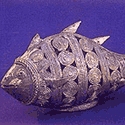
Crochet, Lace, Braiding, Knitting, Endangered/ Red List
Camel Girth / Split Ply Braiding and Animal Trapping of Rajasthan
These are called the split ply camel girths of Rajasthan. They are worked by hand and the loom is not used; they are simple, decorative and useful. The sturdy girths of the camels are prepared using a unique technique mainly using goat hair; cotton cord is also used sometimes. The black or white hair of the goat is woven into yarn on the spindle. The yarn is doubled to make it two-ply; four-ply yarn is used for girth, with each ply being two-ply. To make the four-ply yarn a mixture of black and white, two white two-plys are plied with two black two-plys. The four-ply is highly twisted as it needs to be manipulated, twisted and untwisted in the processing. After twisting, the four-ply yarn is soaked in water and stretched out in the sun to dry. This removes the kinks, opens up and thickens out the yarn and sets the over twist.
When the yarn is dry, the four-ply cords are looped and slipped on to a wooden stick or spindle. The adjacent plys are taken, and the ply of one cord is split open with the eye end of a large wooden needle and untwisted to a quarter of a turn; the next cord is threaded through the eye and is pulled back through the first strand. The adjacent cords have this process done along the row, and worked down, row by row, where each individual cord reaches down and across the newly created fabric on a diagonal line ending on the selvedge. The direction of the cord turns down and across in the opposite side and ultimately zigzags down the fabric from selvedge to selvedge. The pattern is decided by the girth-maker who decides whether the cord is split or to be split by the cord it meets along the opposite diagonal.
There are standard variations in pattern. These are monochrome (some colour, mainly black), a black and white diagonally chequered pattern, or alternating black and white horizontal waves. The best pattern is when the four ply yarn is half black and half white. The cord here is untwisted in the cord splitting process so that two plys of the same colour remain on the surface. The diagonally interlaced layer of one colour lies on the top of the diagonally interlaced layer of the other colour in the refined technique. When the cord is twisted, colours are counter-changed and the free-floating layers are linked together.
Items such as camel girth, necklace, anklet, knee band, bridle etc are created under this craft-form. Tools such as wooden hook are used for crafting purposes.
Gallery
YOUR VIEWS
PRACTITIONERS: INDIA
Access 70,000+ practitioners in 2500+ crafts across India.
BIBLIOGRAPHY
10,000+ listings on arts, crafts, design, heritage, culture etc.
GLOSSARY
Rich and often unfamiliar vocabulary of crafts and textiles.
SHOP at India InCH
Needs to be written.





